The PermaDesign Weblog, with Nate Downey and Melissa McDonald!
The Future is Bright—and Fishy
From my latest Permaculture in Practice column:
Property owners have a special responsibility now that much of the United States government has been pirated by a self-serving school of science-deniers. Yes, our public lands face peril, and every conscious soul must demand protection for the resources upon which we depend. But those blessed with the privilege of owning private land must do more.
In “Make America smart again” (January 2017), I encouraged readers to check out the aquaponics class offered at the Santa Fe Community College. Aquaponics systems grow fish, leafy greens, vegetables, and fruits in small spaces using very little water and few outside inputs. Systems require specific knowledge and an initial financial investment, but once established they only need a small amount of regular maintenance. There’s almost no weeding, yields are extremely high, and systems can be installed anywhere.
Fortunately, the college happens to have hired one of the world’s top aquaponicists, R. Charlie Shultz. Overflowing with dedicated students, his class consistently provides hands-on, detailed, and inspirational material. Shultz teaches with Ivy League authority, southern hospitality, and an enchanting and creative open-mindedness that fits in well with New Mexico.
Having spent most of his career in St. Croix at the University of the Virgin Islands, Shultz worked under the father of aquaponics, Dr. James Rakocy. But Shultz also has extensive aquaponics experience in a variety of climates — from the mining-mired mountains of Kentucky and the eleven-month winters of Canada to the aquifer-challenged hill country of Texas and the muggy marshes of Mississippi. Shultz clearly knows his stuff, and his stuff is game-changing.
On the first day of class, Shultz explained that aquaponics is a hybridization of hydroponics (growing plants in water rather than soil) and aquaculture (fish farming). In the process of creating this hybrid, however, aquaponics requires three types of organisms. You are not just growing fish and plants. You are also growing a microbial ecosystem.
With a few dominating forms of ubiquitous bacteria, a functioning aquaponics ecosystem converts fish excreta (primarily ammonia) into nitrite and ultimately nitrate. Plant roots then use the high levels of nitrate to support plant growth, while they simultaneously filter out toxins. The resultant filtered water can then be directed back to the fish, and the only water you lose is that which transpires through the plants or splashes and evaporates out of the fish tanks — which are mostly enclosed and protected from direct sunlight.
Critics will say that the nutrition associated with soil-less plants will never be as high as the nutrition plants get from rich, organic soil. But this planet lacks arable land, and the ever-rising number of extremely hungry Earthlings is close to one billion.
Modern aquaponics is a relatively new but important widget in the tackle box of sustainability, and with a little knowledge you can do it in your living room, your backyard, or maybe in the soon to be vacant Whole Foods building on St. Francis Drive — with its lovely views of the bold Sangre de Cristos with the fragile Pecos Wilderness beyond.
03/06/2017 | (0) Comments











Comments